The easiest time to tell whether goldfish are male or female is during spawning season. In the wild, this is in the spring and summer, though could be any time of year in the home aquarium.
When spawning, male goldfish will develop spots on their gills and pectoral fins. While female goldfish will have a swollen vent under their tails.
The fish will also act differently, with male goldfish chasing female goldfish much more than usual.
By looking out for each of these clues during the spawning season, you can work out which of your goldfish are male and which are female.
Key Takeaways:
- Identifying Male Goldfish: Males develop spots on their gills and pectoral fins during breeding season and often chase females. They release milt to fertilize eggs.
- Identifying Female Goldfish: Females have a swollen vent, which becomes more pronounced during breeding. They are usually chased by males and lay eggs.
- Breeding Tubercules: Male goldfish develop small white spots, known as breeding tubercles, on their gills, pectoral fins, and around their eyes, which signal their readiness for breeding.
- Chasing Behavior: Males chase females during breeding, while females are typically the ones being chased. However, chasing behavior can sometimes be misleading, especially with younger goldfish.
- Milt vs. Eggs: The most reliable way to identify gender is to observe whether the goldfish is releasing milt (male) or eggs (female).
- Sexual Maturity: Goldfish reach sexual maturity at around one year old, and gender characteristics become more prominent as they mature.
- Physical Differences: Males tend to have thinner, smaller bodies and more flowing fins, while females are typically rounder, with a larger abdomen, especially during spawning.
FAQs:
- Can goldfish change gender?
- No, goldfish are born with a specific gender and do not change throughout their lives.
- Are there specific breeds that are easier to identify by gender?
- Yes, some goldfish breeds, like the bubble-eye goldfish, show more pronounced gender traits, making identification easier.
- Is it necessary to know the gender of my goldfish if I don’t plan on breeding them?
- It’s not essential but can be helpful for understanding social dynamics in your tank.
- Can stress affect the accuracy of gender identification in goldfish?
- Yes, stress and environmental factors can impact the clarity of gender characteristics.
- How often should I check for changes in my goldfish’s gender expression?
- Regular observation is important, especially during breeding season when gender characteristics become more noticeable.
Identifying Males
- Have spots on their gills
- Have spots on their pectoral fins
- Chase females
- Release milt to fertilize eggs
Identifying Females
- Have a vent that lumps out
- Get chased by males
- Lay eggs
Let’s look at some pictures of male and female goldfish so that you know what to look out for.
How the vent tells you whether a goldfish is male or female
In goldfish, the vent serves two purposes. It’s how they release waste and it’s how they breed.
Females release eggs through their vent, while males release milt, which fertilizes the eggs.
The vent in a male goldfish is flat and not very noticeable. It’s just a small slit hidden away under their tails.
In female goldfish, the vent will become swollen and puffed out during breeding season.
The difference can be seen in the photos below, from Bristol Aquarists Society.


Identifying breeding tubercles on male goldfish
Male goldfish will get small white bumps that appear on their gill covers, these are called breeding tubercles.
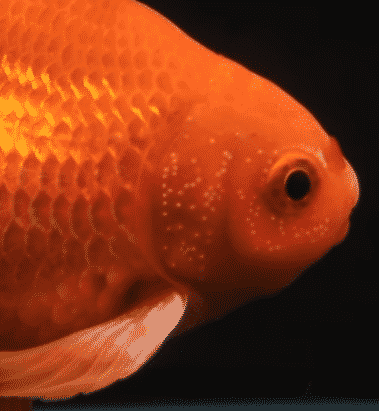
The spots or “breeding stars” usually also appear on the fish’s pectoral fin, as you can see in the photos below.
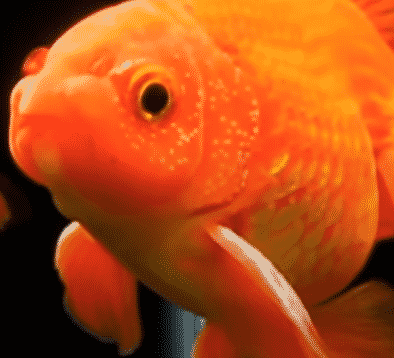
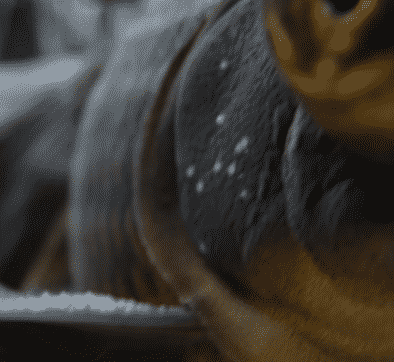
What are breeding tubercles for?
It’s not completely clear what goldfish breeding tubercles are actually for. However, the scientific evidence suggests they help to show that the male goldfish is in a healthy breeding condition.
Male goldfish with more breeding tubercles tend to be healthier and breed more successfully.
The tubercles could therefore be an outward sign to female goldfish that a male is a good choice of mate.
Understanding Difficulties
The white breeding tubercles can easily be mistaken for white spot disease, also known as Ick or Ich.
You should verify that spawning season is happening before trying to treat any disease. Inappropriately treating a disease can cause disruption to the spawning time and health of the aquarium or pond.
Breeding stars appear as small dots in a very neat, regular pattern. They’re also most commonly found on the gills and pectoral fins (though can be found anywhere on the goldfish).
Ich causes similar-looking white spots, but the spots tend to vary in size and appear with no organized pattern. They also appear randomly, all over the fish.
Chasing behavior during spawning season
During spawning season, male goldfish will chase females around and bump them into the sides of the tank.
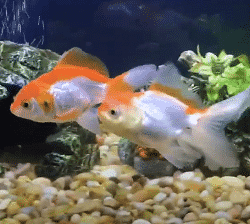
Seeing one goldfish chasing another like this gives you a clue about whether they are male or female.
Chasing suggests that the fish is male. While being chased suggests the goldfish is female.
However, this isn’t always a foolproof system. Particularly if you are housing different ages of goldfish in the same tank.
Sometimes, when pheromones are released by fish that are spawning, younger immature goldfish will start to act out behaviors that aren’t appropriate to their gender.
You may think you have a female because it is being chased, but then the following year it gets breeding tubercles and you realize it’s a male.
Chasing behavior should always be combined with other signs (such as breeding tubercles or releasing eggs or milt) in order to accurately work out whether a goldfish is male or female.
Releasing eggs and milt: The easiest way to tell if a goldfish is male or female
Of course, the easiest possible way to work out whether a goldfish is male or female is to spot them releasing milt or eggs.
Clearly, if you see a goldfish releasing eggs then you know it’s a female. And if you see a goldfish release milt then you know it’s a male.
But what does this look like?
Here are some pictures to help.
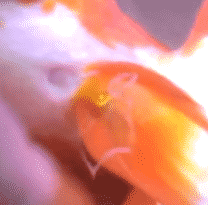
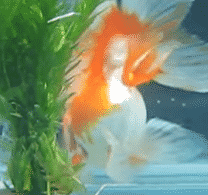
How old do goldfish need to be to tell if they are male or female?
The physical differences between male and female goldfish will only show once the fish has reached sexual maturity and is in good health.
The normal age for a goldfish to reach maturity is above one year of age. However, fish can sometimes reach maturity earlier or later.
If you are trying to breed goldfish, then the best thing to do is buy six fish from the same tank at the store because you have a high chance of getting a male and a female.
Just be sure that you have a large enough tank or pond to house them all safely.
Other physical characteristics of male vs female goldfish
The primary signs of male vs female goldish are:
- Spots on the gills and pectoral fins during breeding season (males)
- A vent that sticks out (females)
- Chasing (males) and being chased (females)
- Laying eggs (females) and releasing milt (males)
More subtle – and less reliable – secondary signs include:
- The pectoral fin in male goldfish tends to be thicker and longer.
- Pectoral fins are usually more pointed in males compared to females.
- The anal fin in males is closer to the tail compared to females.
- Male goldfish tend to have more flowing fins and tails compared to females.
- Male goldfish tend to have a slightly smaller and skinnier body compared to females.
- Females will have a larger and rounder body and their abdomen can appear soft.
- Females can be asymmetrical during spawning season when looked at from above due to the egg development.
- Often, females are deeper-bodied compared to males when they are looked at from the side.
- A ridge that runs through the rear of the pelvic fins and to the opening of the vent is often more pronounced in males and smaller or absent in females.
However, these secondary rules don’t hold true for all goldfish. We, therefore, recommend not drawing any firm conclusions about whether a goldfish is male or female until you spot some of the primary signs.
FAQs
- Q: Can goldfish change gender?
A: No, goldfish do not change gender. They are born with a specific gender and maintain it throughout their lives. - Q: Are there specific breeds that are easier to identify by gender?
A: Yes, some breeds, like the bubble-eye goldfish, exhibit more pronounced gender-specific traits, making identification easier. - Q: Is it necessary to know the gender of my goldfish if I don’t plan on breeding them? A: While not essential, knowing the gender can help in understanding and managing the social dynamics within your tank.
- Q: Can stress affect the accuracy of gender identification in goldfish?
A: Yes, stress and environmental factors can impact a goldfish’s ability to express its gender characteristics accurately. - Q: How often should I check for changes in my goldfish’s gender expression? A: Regular observation is key. Changes in behavior and physical characteristics, especially during the breeding season, should be monitored periodically.
Do fancy goldfish eat there fry? Or do they nurture them please.
Hi Antony – thanks for your question. All goldfish will eat fry if given the chance!
They eat the babies.
I have 2 goldfish, a male and a female. I’ve had them for 3 and half years and they haven’t mated yet. Why?
maybe they’re actually the same gender? body shape isnt a 100 percent accuracy ive seen a video of someone gently stroking along the stomach towards the tail of his goldfish and push out either eggs or milt
Thanks for your comment Vicki,
Yes this is correct, body shape varies between individuals, and what may look like a female may be a male and vice versa.
The video you have seen is what is called “Milking goldfish” this is a practice widely used by goldfish breeders, although it is not recommended to milk a fish unless you are professionally trained or shown how to do it properly, as improper handling can cause internal damage to the fishes organs.
Yep! It also has to be done with hens sometimes (as gross as that is…read about where they come from — plus I HATE chickens, but love them dead. They are a disgusting animal, especially reproducing.
Sorry, not trying to beat up on them, but that’s just me!
HI TerraLynn,
Thanks for commenting, goldfish naturally spawn in schools where they feel most comfortable in larger numbers.
You will know when they are spawning as the males develop rough bumpy white spots on their pectoral fins and gill plates.
Part of their courtship is for the males to chase females at high speeds, so you may need to increase their tank or pond size if it is too small.
goldfish will also only spawn if they have a place to drop their eggs, usually this is within plants or moss.
Hope this helps.
They might have. But they eat the eggs.
Hi how long do goldfish lie for?
With proper care, the average goldfish can live over 20 years, with some being said to live to the age of 40.
It all depends on the care.
Goldfish that live in colder water or in an outdoor pond, will live much longer than ones in a small, warm tank.
Hello my name is Naomi.
My son won 2 gold fish on his very 1st try at a fair. One is gold in color and one is dark in color. I have been reading up for what they have been doing in their tank we have only had them for maybe a week and I think they’re mating. They have been chasing each other Non-Stop it’s actually pretty funny to watch This is our first time with goldfish what should I do??? Lol
Hi Naomi,
It would be unusual for goldfish to settle in enough to breed after 1 week of owning them, spawning only really occurs in mature goldfish that are established in their home, the fish would need to be at least 2 years old, and over 4″ long to do this.
Spawning would also only consist of one fish chasing the other (male chasing female) and they would not chase each other in turns.
The best way to tell if they are mature and spawning is if the male has little white bumps on his gills and front fins.
If he does not then they are likely not spawning.
If they aren’t spawning, then this is likely aggression.
Goldfish arent inherently aggressive fish and any bickering is caused by them being uncomfortable, maybe the tank is too small, the water temperature is too high or the water quality is poor.
We would highly recommend testing your water to see if there is anything wrong.
You can pick up a test kit online or at a store, or you can bring a sample of your water to a petstore and they can test it for you.
If the water is bad, then we suggest doing a 20% water change.
we have a page on goldfish aggression and how to avoid it here:
https://thegoldfishtank.com/goldfish-care/tank-mates/goldfish-bully-handle-aggressive-goldfish/
hope this helps, and good luck with your two new goldfish 🙂
I have a fancy goldfish and it’s approx 4 inch long (I don’t know what gender, it won’t get in the right position for long enough) what size tank does it need as I’m thinking of getting a companion for it, also what do you do if you think it’s ill but not entirely sure?
Please help
Hi Emily,
Different breeds of fancy goldfish will grow to different sizes, but all of them will get around the size of your palm or larger, (around 7″ is quite common)
To determined the sex of the goldfish you can look at them from above, females tend to have rounder, shorter bodies, however, this is hard to do on fancy goldfish as they all seem to have round bodies.
The best way to tell is when they are in breeding condition and the males develop rough bumpy spots on their gill plates and pectoral fins.
as for tank size, ideally you want a tank around 4ft long at least, something that holds around 40-50 gallons.
If you want to add another goldfish this is okay, just add another fancy goldfish of a similar size, and you will need more space.
For two adult fancy goldfish, a 75 gallon tank should allow them to live comfortably.
We didn’t use our above ground swimming pool so we turned it into a fish pond. They love it and we have 5 adults and 10 babies. I’m anxiously waiting to see if we get more babies this spring or summer.
I have a gold fish and a dalmatian molly I don’t know the gender of either but the molly keeps chasing my goldfish. Do you think it’s aggression?
Sounds like aggression stormy, mollies can get a little nippy when they are uncomfortable, perhaps check your water parameters, maybe something is wrong, or maybe you need some more mollies to balance out the aggression.